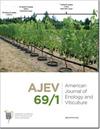耐寒风土:安大略雷司令的芽LT50、水分指标、产量和浆果成分
IF 1.8
3区 农林科学
Q3 BIOTECHNOLOGY & APPLIED MICROBIOLOGY
引用次数: 2
摘要
葡萄的抗寒性除了受到极端天气条件的影响外,还受到几个因素的影响,如特定地点的土壤因素(质地、成分、水分、排水)、葡萄的水分状况和产量。据推测,冬季耐寒性将受到特定葡萄园风土驱动因素的影响,低水分状态(叶水势[Ψ])的葡萄园区域同样比高水分状态(负叶Ψ较少)的葡萄藤更耐寒。安大略省尼亚加拉地区共有六个雷司令葡萄园。2010年至2012年,在结实期、滞后期和veraison(土壤含水量[SWC]、叶片Ψ)、收获期(产量成分、浆果成分)和冬季三次(LT50;50%芽死亡的温度)收集数据。使用克里格法完成变量的插值和映射,并进行统计分析(线性相关、k-means聚类、主成分分析、多元线性回归)。SWC、叶片Ψ、产量组成、浆果成分和LT50在每个葡萄园中都是空间聚类的。GIS和多元线性回归表明,叶片Ψ可以预测LT50值,在2010年至2011年的大部分葡萄园区块中,LT50与叶片Ψ值之间存在很强的相关性(分别为4/6和5/6)。在2012年极度干旱的季节,叶片Ψ(在veraison 0.9至1.4MPa的位置范围内)与LT50、产量、可滴定酸度、pH和Brix呈正相关,与SWC和单萜浓度呈负相关。结果表明,与风土的其他方面一样,抗寒性也有空间成分。这项研究提供了一种将抗寒性与其他关键变量进行比较的方法,以更好地了解尼亚加拉地区基于风土的因素。本文章由计算机程序翻译,如有差异,请以英文原文为准。
Terroir of Winter Hardiness: Bud LT50, Water Metrics, Yield, and Berry Composition in Ontario Riesling
Grapevine winter hardiness is governed by several factors besides extreme weather conditions, such as site-specific soil factors (texture, composition, moisture, drainage), vine water status, and yield. It was hypothesized that winter hardiness would be influenced by specific vineyard terroir-driven factors and that zones in vineyards with low water status (leaf water potential [Ψ]) would likewise be more winter hardy than vines with high water status (less negative leaf Ψ). Six Riesling vineyards were chosen throughout the Niagara region in Ontario. Data were collected at fruit set, lag phase, and veraison (soil water content [SWC], leaf Ψ), at harvest (yield components, berry composition), and three times during the winter (LT50; the temperature at which 50% of buds die) in 2010 to 2012. Interpolation and mapping of variables was completed using kriging, and statistical analyses (linear correlation, k-means clustering, principal components analysis, multilinear regression) were performed. SWC, leaf Ψ, yield components, berry composition, and LT50 were spatially clustered in each vineyard. GIS and multilinear regression revealed that leaf Ψ could predict the LT50 value, with strong correlations observed between LT50 and leaf Ψ values in most of the vineyard blocks in 2010 to 2011 (4/6 and 5/6, respectively). In the extremely dry 2012 season, leaf Ψ (range across sites at veraison 0.9 to 1.4 MPa) was positively correlated to LT50, yield, titratable acidity, pH, and Brix and inversely correlated to SWC and monoterpene concentration. Results suggest that there is a spatial component to winter hardiness, as with other aspects of terroir. This study allows a method to compare winter hardiness to other critical variables to better understand terroir-based factors of the Niagara region.
求助全文
通过发布文献求助,成功后即可免费获取论文全文。
去求助
来源期刊

American Journal of Enology and Viticulture
农林科学-生物工程与应用微生物
CiteScore
3.80
自引率
10.50%
发文量
27
审稿时长
12-24 weeks
期刊介绍:
The American Journal of Enology and Viticulture (AJEV), published quarterly, is an official journal of the American Society for Enology and Viticulture (ASEV) and is the premier journal in the English language dedicated to scientific research on winemaking and grapegrowing. AJEV publishes full-length research papers, literature reviews, research notes, and technical briefs on various aspects of enology and viticulture, including wine chemistry, sensory science, process engineering, wine quality assessments, microbiology, methods development, plant pathogenesis, diseases and pests of grape, rootstock and clonal evaluation, effect of field practices, and grape genetics and breeding. All papers are peer reviewed, and authorship of papers is not limited to members of ASEV. The science editor, along with the viticulture, enology, and associate editors, are drawn from academic and research institutions worldwide and guide the content of the Journal.
 求助内容:
求助内容: 应助结果提醒方式:
应助结果提醒方式:


